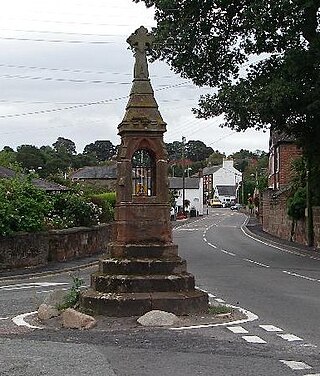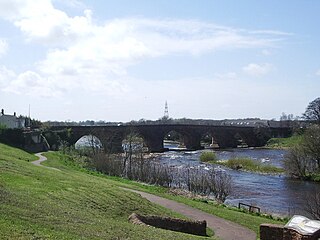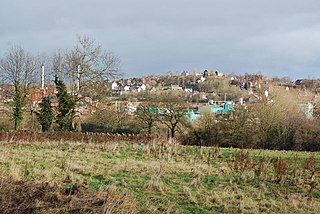
Box Tunnel passes through Box Hill on the Great Western Main Line (GWML) between Bath and Chippenham. The 1.83-mile (2.95 km) tunnel was the world's longest railway tunnel when it was completed in 1841.

Ellesmere is a town in Shropshire, England, located near the Welsh border and the towns of Oswestry and Whitchurch, and the Welsh city of Wrexham. It is notable for its proximity to a number of prominent Meres.

Ruyton-XI-Towns, formally Ruyton of the Eleven Towns or simply Ruyton, is a village and civil parish next to the River Perry in Shropshire, England. It had a population of 1,379 at the 2011 Census.
The Shropshire and Montgomeryshire Light Railway was a railway running from Shrewsbury, England to Llanymynech, Wales, with a branch to Criggion. It was promoted by Holman Fred Stephens, better known as Colonel Stephens, proprietor of several ultra-low budget light railways. It adopted the track network of the defunct Potteries, Shrewsbury and North Wales Railway that had closed in 1880; the S&MLR opened in 1911. Running through sparsely inhabited terrain, it struggled to achieve financial stability, and following a serious deterioration of maintenance conditions, it closed to passengers in 1933, continuing with a basic goods and mineral service.
The Potteries, Shrewsbury and North Wales Railway,, was a railway built between Shrewsbury, England, and quarry locations at Nantmawr and Criggion in Wales. It was initially opened in 1866; despite the extensive title it never reached further than those extremities. It had cost about £1.5 million to construct, but its financial performance was extremely poor, and economies resulted in near-suspension of maintenance, leading to dangerous conditions. The line rapidly became very run down as a result of low revenues and poor maintenance, and was closed at the instigation of the Board of Trade for safety reasons in June 1880. It lay derelict for 30 years but was revived when the Shropshire and Montgomeryshire Railway re-opened it as a light railway in 1911.

Llanymynech is a village and former civil parish straddling the border between Montgomeryshire/Powys, Wales, and Shropshire, England, about 9 miles (14 km) north of the Welsh town of Welshpool. The name is Welsh for "Church of the Monks". The village is on the banks of the River Vyrnwy, and the Montgomery Canal passes through it.
Hersham is a village in Surrey, within the M25. Its housing is relatively low-rise and diverse and it has four technology/trading estates. The only contiguous settlement is Walton-on-Thames, its post town.

Ford is a village and civil parish in Shropshire, England. The civil parish population at the 2011 census was 890.

Longtown is a market town in Cumbria, England, just south of the Scottish Border. It has a sheep market which was at the centre of the 2001 United Kingdom foot-and-mouth crisis. Just south-west of Longtown is Arthuret Church, dedicated to Saint Michael and All Angels.

Kinnerley is a small village in Shropshire, England. It lies between the neighbouring villages of Dovaston and Pentre and the nearest town is Oswestry. To the north is the village of Knockin.

Cefn Mawr is a village in the community of Cefn within Wrexham County Borough, Wales. Its name translates as "big ridge". The population in 2001 was 6,669, increasing to 7,051 in 2011.

Monkton Farleigh is a village and civil parish in west Wiltshire, England, on high ground 3 miles (5 km) northwest of Bradford-on-Avon, and a similar distance east of the city of Bath. The parish includes the hamlets of Farleigh Wick and Pinckney Green. In the west and northwest the parish is bounded by Somerset.

Great Ness and Little Ness are civil parishes in Shropshire, England.
Humphrey Kynaston, aka Wild Humphrey Kynaston, was an English highwayman who operated in the Shropshire area. The son of the High Sheriff of Shropshire, he was convicted of murder in 1491. After being outlawed, he moved into a cave in the area and lived a lifestyle compared to Robin Hood.

Alberbury is a village in Shropshire, England, 9 miles (14 km) west of Shrewsbury on the B4393 road which travels from Ford to Lake Vyrnwy. It is on to the England-Wales border, marked by Prince's Oak.
The logistics organisations of the Royal Air Force in World War II were No. 42 Group RAF and RAF Maintenance Command.

Wittersham Road is a railway station on the Kent and East Sussex Railway. It is located to the north-east of the level crossing on Maytham Road which links the Kentish villages of Rolvenden and Wittersham. Having served the area for over sixty years, the station closed for regular passengers in 1954 and completely in 1961. It was later rebuilt and reopened in 1977 by the Kent and East Sussex Railway heritage organisation.

Llanymynech railway station was an important junction station on the Cambrian Railways mainline from Welshpool, Powys to Oswestry, Shropshire, serving the village of Llanymynech which is partly situated in Shropshire, England and partly in Powys, Wales.

Pontrilas Army Training Area is a British Army training camp, located just north of the village of Ewyas Harold near to Pontrilas in Herefordshire, England. Originally developed pre-World War II by the Ministry of Defence (MoD) as an ammunition dump, it was served by the Golden Valley Railway.

The Nesscliffe Training Area is a military training facility located near Nesscliffe in Shropshire.
















